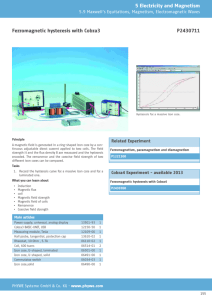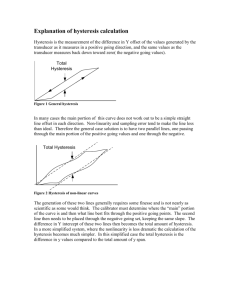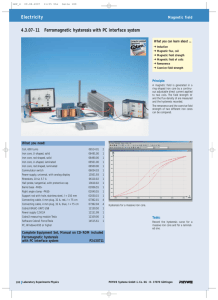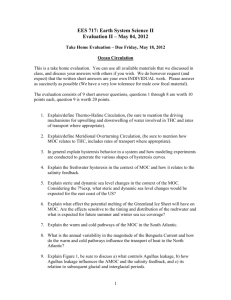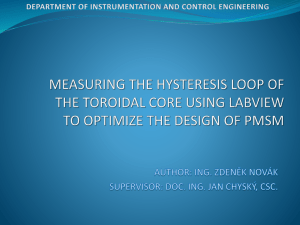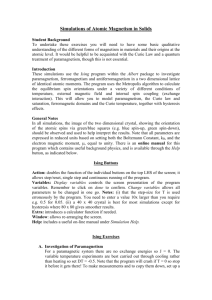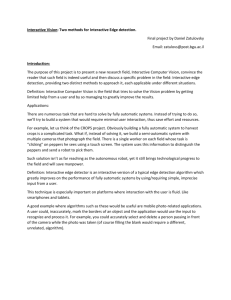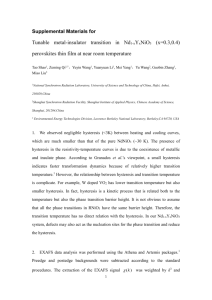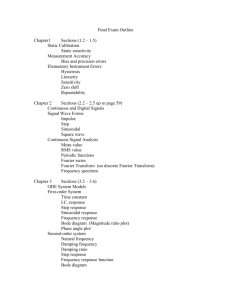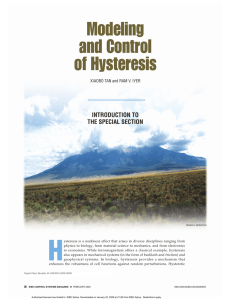here - ECE
advertisement
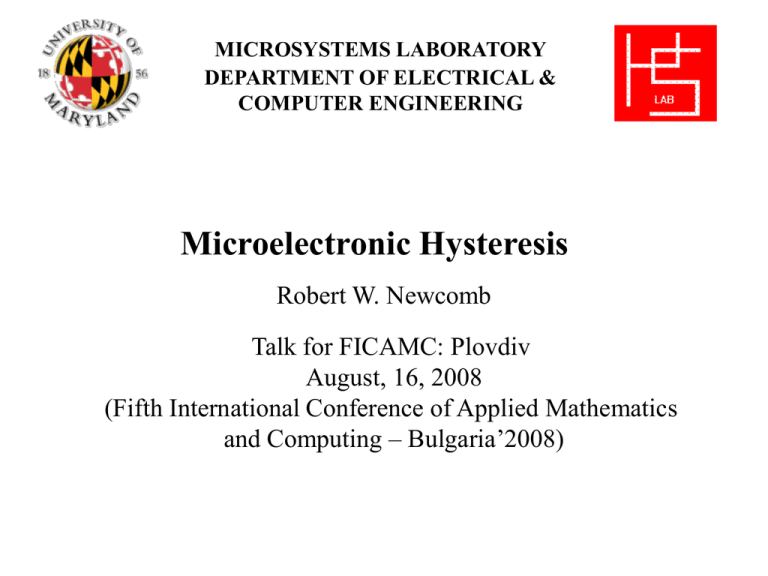
MICROSYSTEMS LABORATORY DEPARTMENT OF ELECTRICAL & COMPUTER ENGINEERING Microelectronic Hysteresis Robert W. Newcomb Talk for FICAMC: Plovdiv August, 16, 2008 (Fifth International Conference of Applied Mathematics and Computing – Bulgaria’2008) 2 The Old Town of Plovdiv by Ivan Theofilov • Your ancient floors float among the stars. Blue donkeys graze the silence around. The Roman road leads down along matrimonial chandeliers. A cry out of woman's flesh calls in the clock. Violet-colored philistines go to bed in the deep houses, they hear the pig, the hens, the train, the mouse. The darkness dawns with quick sensual pupils. The bridal veil flies away with the chimney's breath. Blue donkeys run on the moonlit roofs. Saints take off in a cloud from whitewashed churches, with blood-soaked lambs they welcome the bridal veil. Leopards gaze with amber eyes from the doorsteps. Among box trees bacchantes with satin bands pour fragrant myrrh out of bronze rhytons ... Ivan Theofilov was born in Plovdiv in 1931 and graduated from the Theatre Academy in Sofia. He is an honorary citizen of Plovdiv. The poem translated here is from Geometry of the Spirit, published by Free Poetic Society, Sofia, 1996, and translated by Zdravka Mihaylova 3 Main topic of talk The mathematics for the design of VLSI CMOS circuits for hysteresis controlled by a voltage or current. Possible uses: Chaotic circuits, robust oscillators, memory, debouncing, pixel holding, emulation of chemical reactions, artificial neural networks, buildings in earth quakes Items for discussion: Microlectronic hysteresis concept The main idea, curve with movable load line Representation via semistate equations Key circuits used Some examples 4 The concept for microelectronics Hysteresis (ancient Greek = to lag behind) a) Static: piecewise multi/single valued [reason Spice won't run DC analysis on hysteresis] along with b) Dynamic: single valued given initial conditions Typical (static): binary bent 5 Binary hysteresis curves 6 Example of use for holding pixels in presence of noise 7 Main Idea Slide a load line, which depends upon the hysteresis input parameter, across a nonlinear function to give two or more intersections in one region. ==> 8 CMOS circuit and bent V-I hysteresis using inverters 9 CMOS bent hysteresis design curves 10 Designing all CMOS V-I hysteresis 11 CMOS inverter bent hysteresis 12 Hysteresis use in chaos generation 13 Multilevel hysteresis 14 Typical binary hysteresis circuit OTA = operational transconductance amplifier = voltage controlled current source 15 Variable hystereses 16 4 quadrant current mode hysteresis 17 Variable hysteresis from last circuit 18 Hysteresis in several dimensions From UMCP dissertation of Yu Jiang 19 Circuit to realize 2D hysteresis 20 Dynamics via Semistate Equations Edx/dt = A(x) + Bu y = Cx u = input, y = output, x = semistate B, C, E constant matrices, E may be singular A(x) nonlinear to generate hysteresis 21 Op-amp circuit for hysteresis 22 Semistate equations for op-amp example kσ v out sσo (1 21(v )); 1(x) unit step, s d d dt o r v (1 r1 )(v v ) out d in 2 let u v , x vout , x v , 2 d in 1 f(x) (-1 2 1(x)), k r /r then the semistate equations are 12 1 2 dx 1 σ x kσ f(x ) o 1 o 2 dt 0 x (1 k )x2 k u 1 12 12 yx 1 23 OTA circuit for hysteresis 24 OTA example semistate equations i I f(v ) out T d d(v ) d g(v v ) i Cgs out d in dt With v x , i x y, v u d 1 out 2 in the semistate equations are dx Cgs 1 g x g u - x 1 2 dt 0 x I f(x ) 2 T 1 yx 2 25 OTA CMOS circuit 26 OTA curves IT epsI 1.1 10 4 8.8 10 5 6.6 10 5 4.4 10 5 2.2 10 5 iOTA( vd) 0 IT epsI 0 2.2 10 5 4.4 10 5 6.6 10 5 8.8 10 5 1.1 10 4 5 vdmin gimax 2 IT 4 3 2 1 0 vd 1 2 3 4 vdmax 5 27 Sliding load line on OTA curve 1.1 10 4 8.8 10 5 6.6 10 5 iOTA ( vd) 0 4.4 10 5 igi[ go ( 2 vi2( go) ) vd] 2.2 10 5 IT epsI igi( go vi2( go) vd) 0 igi( go vi2( go) vd) 2.2 10 5 igi( go 2 vi2( go) vd) 4.4 10 5 6.6 10 5 8.8 10 5 1.1 10 4 IT epsI 5 vdmin 4 3 2 1 0 vd 1 Hysteresis for case of last curves. Uses two curves, upper & lower 2 3 4 vdmax 5 28 Resulting OTA hysteresis, Iout vs Vin IT epsI hu( vi go) hl( vi go) IT epsI 1.1 10 4 8.8 10 5 6.6 10 5 4.4 10 5 2.2 10 5 2.2 10 5 4.4 10 5 6.6 10 5 8.8 10 5 1.1 10 4 0 5 vimin 4 3 2 1 0 vi 1 2 3 4 vimax 5 29 OTA VLSI layout 30 Neural type cell circuit 31 Neural type cell hysteresis 32 CMOS resistor from OTA Floating resistor; can be positive or negative (by reversing green Leads to M1 & M2) M10 1 A 2 I adj K1, 2 M3 M4 M6 -Io(IR-) Io(IR+) M1 M2 V+ V- M11 R M5 M7 M9 Vadj 1 A(Vadj Vss ) 2 K1, 2 K 9 M8 33 PSpice Simulation: Positive Floating Resistor Circuit • Observations – Linear I-V region centered at V+ – V- = 0V – IR+ and IR- show good symmetry – Vadj modulates I-V linearity range magnified 0.6 IR+ IR+, IR- [ A] IR+, IR- [ A] 1.0 0.5 0.0 -3.4v 0.0 IR- -0.3 -0.5 -1.0 -6.0 0.3 -4.0 -2.0 0.0 2.0 V+ – V- [V] 4.0 6.0 Vadj= -2.4v … Vadj= -3.4v … -2.4v -0.6 -1.5 -0.75 0.0 V+ – V- [V] 0.75 1.5 34 dx x3 ( ) x2 σ x k z o 1 2 1 2 dt dz k x k z u 2 dt 1 for d(.)/dt 0: z ( 1 )x(x σ )(x σ ) 1 ko 1 2 z ( 1 )(k u) 2 1 k 2 0.922 Plot for σ1=- σ2=1, ko=1=k2=2k1 u3=0.136 at = slopes Kinetic cells 1 0.9 0.8 0.7 0.6 0.5 z1( x) 0.4 0.3 0 0.2 z2( x 2 u3) 0.1 z2( x u3) 0 0.1 z2( x u3) 0.2 z2( x 2 u3) 0.3 0.4 0.5 0.6 0.7 0.8 0.922 0.9 1 1.3 1.13 0.95 0.78 0.61 0.43 0.26 0.08670.0867 0.26 0.43 0.61 0.78 0.95 1.13 1.3 xmin x xmax Reference: V. Petrov, M. Peifer, J. Timmer, “Structural Stability Analysis of a Cell Cycle Control Model,” Comptes rendus de l’Academie bulgare des Sciences, Tome 58, No. 1, 2005, pp. 19 – 24. 35 2 ) /(2I Circuit to give Iout=(Ix+Iy w) Subtract Ix2/(2Iw) & Iy2/(2Iw)to get I=IxIy/Iw Iterate (= cascade connections) to get cubic, etc. W. Gai, H. Chen, E. Seevinck, “Quadratic-translinear CMOS Multiplier divider circuit,” Electronic Letters, May 1997, p. 860 36 Configuration to give cubic products 37 NPN differential pair Apply differential voltage Vd and tail current Io then Iout=I2-I1=Io·tanh(Vd/(2VT)), VT=thermal voltage=KT/Q I2+I1=Io => 2·I2=Io(1+tanh(Vd/2VT) 2·I1=Io(1-tanh(Vd/2VT) Multiplier via npn differential pair Iout=(I4+I6)-(I3+I5) =Io·tanh(Vx/2VT)tanh(Vy/2VT) 38 39 Cubic via npn differential pair: Iout=Io·tanh(vx)tanh(vy)tanh(vz) <=take diff=> <=from previous=> 40 VLSI Transistors Two basic types with two complementary of each: MOSFET: NMOS & PMOS [piecewise square law] BJT: npn & pnp [exponential law] NMOS Law For VGS ≤ Vth ID=0 off For VGS>Vth ID=(VGS-Vth)2 if VGS-VthVDS saturation =(2(VGS-Vth)VDS-VDS2) if VGS-Vth<VDS Ohmic =(Cox/2)(W/L) If l ≠ 0 multiply by (1+lVDS); for now Vth>0 41 42 Useful CMOS current circuits 43 Setting up semistate equations Use graph theory: vb & ib = branch voltages and currents vt & il = tree voltages and link (cotree) currents KCL: 0t = Cib KVL: 0l= Tvb ==> vb = CTvt ib = TTil ib=idevice+isource=id+is ; vb=vd+vs by equivalences for devices id=Y(vd) 44 Useful equivalences 45 Example of setting up equations Cutset equations = KCL at nodes I and II 0 1 0 1 1 0 i i ; ib i in 1b 0 0 1 0 1 1 b i i i i 2b 3b 4b 5b T 46 Device characterization 0 i1d i I (v ) D1 1 2d v1 ; v t i d i 3d 0 v2 i 4d sC(v1 v 2 ) i 5d IS2 (v 2 Vdd ) 0 i in 1 0 1 1 0 0 0 0 1 0 1 0i d 0 i in C C v1 s 0 C C v I (v ) I (v V ) 2 D1 1 S2 2 dd 47 Final semistate equations 0 1 1 1 dv t C i 1 1 dt I D1 (v1) IS2 (v 2 Vdd ) 0 in v 1 0v out t 48 Idea of an extension In terms of binary hysteresis can set up a Preisach’s type of theory: u y(u) w(x)dh(x) uo N w n h n (u) n1 Where h is binary hysteresis and w is a weight 49 Alternate CMOS OTA hysteresis 50 CMOS OTAVout/Vin hysteresis circuit 51 Vout/Vin OTA hysteresis VLSI Layout for 1.2U AMI fabrication Vdd Vr 52 6 main transistors 10ux10u, cap 38ux32u Out In Vb Gnd
